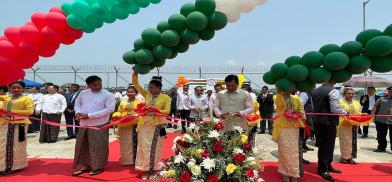Operationalisation of Sittwe Port in Myanmar can positively impact regional development: India has great stake in early completion of Kaladan project
For KMMTTP to be a success, locals from both India and Myanmar must be involved as project stakeholders. And India, while economically supporting the project, should also politically back Myanmar's return to democracy.

After the Act East Policy of 2014, connectivity with Southeast and East Asia have received a lot of precedence in Indian foreign policy. Construction of roads and railways and upgrading of existing routes are common sights across Northeast India from where the connectivity projects run till Southeast Asia. According to India's Finance Minister Nirmala Sitharaman, connectivity projects worth Rs 1,34,200 crore have been taken up by the Modi government. Maintaining robust connectivity with the neighbouring countries of East and Southeast Asia can bring great economic and strategic benefits to India. The recent operationalisation of the Sittwe Port in Myanmar on 9 May 2023 was one such development that can fulfill the goals of enhanced regional connectivity.
The Sittwe Port is part of a larger physical connectivity project called the Kaladan Multimodal Transit Transport Project (KMMTTP) that was envisaged by India and Myanmar in 2008 as a project of "strategic significance". The KMMTTP opens an alternate route to Northeast India from the Indian mainland rather than through the narrow Siliguri Corridor. The push by the government of Prime Minister Narendra Modi on these projects reflects an urgency to strengthen India’s northeastern region and optimise its untapped economic potential.
Located on the Kaladan River in Myanmar, the $500 million port was built with India’s aid. This terminal consists of riverside pier jetties, which can only handle small-sized general cargo vessels. The first Indian cargo ship MV-ITT LION (V-273) docked at this new terminal of the Sittwe Port on 9 May. It was received by India's Shippings, Waterways and Transport Minister Sarbananda Sonowal. The ceremony marked the beginning of regular transit of cargo vessels between Syama Prasad Mookerjee Port in Kolkata and Sittwe Port in Myanmar.
Prospects for developmental gains
The Sittwe Port can bring enormous economic developments to both India and Myanmar. Important items of export through Sittwe Port from Myanmar to India include rice, fish, timber, garments, textiles and petroleum products. Items of import through Sittwe Port by Myanmar include construction material like cement, steel and bricks. After the operationalisation of this new terminal, the cost and time of transportation of goods between Kolkata and Agartala and Aizawl can potentially decrease by more than 50 per cent.
Engaging with Southeast Asia has a developmental subtext of enhancing growth in Northeast India. The northeastern region remains relatively underdeveloped compared to the rest of India. It was believed that strengthening ties with Southeast Asia, specifically Myanmar which shares a border with four northeastern states in India, could foster development and unlock the economic capacities of Northeast India. The opening of Sittwe Port will immediately benefit Mizoram and Tripura; the journey from Kolkata in West Bengal to Agartala in Tripura usually takes four days by road. With the completion of the water and land component in the Sittwe-Chittagong-Sabroom-Agartala route, the journey can come down to two days.
Apart from the reduction in travel time and low carbon emissions, sectors like agro-horticulture, bamboo, processed food and rubber can gain from the opening of Sittwe Port. In Tripura, natural rubber is found in huge quantities and has become India's second-largest producer. The opening of Sittwe Port can give a boost to the rubber industry in Tripura and promote vast employment in the region.
Sittwe Port can also contribute to the development of the regional economy in the neglected Rakhine State in Myanmar. Rakhine State is a challenging zone for economic and political developments because of the persistent ethnic conflict between the rebel Arakan Army and the political dispensation in Myanmar. The ethnic conflict has displaced 73,458 individuals across 11 townships. Myanmarese military officials believe that opening of the Sittwe Port can open up new opportunities in the underdeveloped Rakhine State.
KMMTP needs early completion
However, the full potential of this port can be realised after the KMMTTP, that has missed several completion deadlines, is completed. It was supposed to have been completed by 2015. The economic capacities in Northeast East India cannot be unlocked just by the Sittwe Port until the road component of the KMMTTP is over. The 110 km road from Paletwa in Myanmar to Zorinpui in Mizoram faces the biggest challenge in completion. The road clearance for construction happened only after a long delay by India. Then, security issues due to ethnic conflicts kept stalling the project. Then came the kidnapping of Indian construction workers by the Arakan Army in 2019. Construction was again delayed when the pandemic hit. Later, ethnic conflicts increased when the democratic government was toppled in Myanmar by the military junta in 2021.
Additionally, the effort by Myanmar to engage local subcontractors for the project has been facing challenges as no public announcement for the selection of subcontractors has been made so far. Also, the potential of the Sittwe Port to trade goods, gas or oil to Northeast India through a strategic transport route is uncertain due to the anticipated high costs associated with frequent bulk breaking and transshipment.
An even more troubling issue is the current political instability in Myanmar. Any private investor will rethink their decision to put money in an economy that suffers from a ‘government deficit.’ The 2021 coup in Myanmar and the stifling of democratic values has also put some question marks on the project despite the military junta supporting its opening due to New Delhi's keenness to have it going. This decision reflects India’s strategic interest in Myanmar at a time when Chinese engagement with Myanmar has only been increasing. However, India’s delivery is known to be sluggish and falls far behind China’s efforts to build infrastructural projects in Myanmar at a fast clip.
It is imperative that until ethnic issues are resolved, progress in connectivity will be slow. The locals need to be made aware of the benefits such as employment opportunities of these projects. The restoration of democracy in Myanmar is the primary factor which can guarantee the success of the Sittwe Port and the KMMTTP.
The early completion of KMMTTP is essential for this port's future and before the northeastern region of India can realise its economic potential via the Bay of Bengal. For KMMTTP to be a success, locals from both India and Myanmar must be involved as project stakeholders. And India, while economically supporting the project, should also politically back Myanmar's return to democracy.
The opening of Sittwe Port, though much delayed, can have a positive impact on regional development by generating economic and strategic benefits as well as opportunities for intercultural exchange. But these potential gains can be offset by manifold problems. The success of the port will remain in doubt if such issues are not quickly overcome.
(The author is a post graduate student of political science from Presidency University, Kolkata. Views are personal. She can be contacted at manishitadas90@gmail.com)














Post a Comment